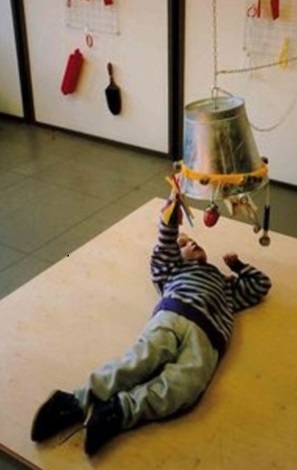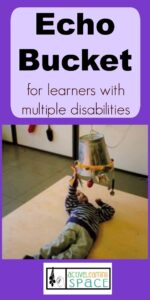Echo Bucket

Many children who have significant disabilities may not use their voice to develop speech or develop important listening skills. These skills are often the focus of the speech therapist or teacher of the deaf and hard of hearing if the child has a hearing impairment. Goals such as discriminate between two sound sources, vocalize spontaneously using various vowel-consonant sounds, or alerting to sounds can all be worked on using an Echo Bucket.
The echo bucket activity is one way for the child to have opportunities to play with their own voice, listen for the sounds of specific objects attached to thee bucket, and to contrast the difference between a human voice and the sound that objects make.
The echo bucket is a metal bucket that has a chain attached so that it can be suspended upside down from a strong support by teachers. Holes have been made around the rim and objects are tied with elastic.
Use
The child with low vision lies on a resonance board with the bucket hanging over him/her.
The child can interact with the object and make sounds which are echoed within the bucket. This, in turn, will encourage the child to make more sounds.
Suspend the Echo Bucket from the ceiling or other sturdy horizontal structure so that it will hang above the child’s head. You want to encourage reaching and moving the object to produce sounds.
You also want the child to be able to hear his own voice if he vocalizes in response to the sounds he is making. Increasing the child’s vocalizations, use of various pitches and rhythms with his own voice, and imitating sounds he hears is speech training.
If a child has any type of hearing impairment it is important to find objects that make sounds he might be able to hear. Playing with various objects that make various sounds so the child can begin to associate objects with specific sounds is auditory training. Learning to be more efficient with the use of hearing is important for any visually impaired child.
Make sure both the objects and the bucket are securely attached, especially if the child has a lot of strength and can pull. Always make sure any equipment is safe before using with a child.
It is also recommended that the child be placed on a Resonance Board while playing with the Echo Bucket.
Dr. Nielsen suggests that low frequency sounds are better than high frequency sounds. She also mentions that the learner could create various sounds depending on how the child interacts with the objects.
Some ideas for objects with interesting auditory qualities includes:
- Two metal teaspoons or a set of metal measuring spoons
- A slightly inflated balloon
- Key bunches of various shapes and materials
- Small hand bells (e.g. brass dinner bell)
- Triangles and windchimes
- Bicycle horn
- Mouth organs, flutes
- Castanets
- Net containing hazelnuts or other hardwood nuts
- Tuning fork
- Slinkies
- Materials Needed
- Bucket (metal is preferable)
- Elastic (1/4 “)
- Objects made of various materials that produce interesting sounds when manipulated
- Elastic
- Chain or rope (to hang the bucket)
- Mini cord locks
Design and Build
- Using a drill make holes evenly spaced around the open end of the bucket (about 3-4 inches apart) and in the center of the bottom panel (for the rope of chain)
- Select a variety of objects and secure them to an elastic cord about 10-12” long
- Attach the elastic to the bucket by inserting it through the holes and securing it with mini cord locks or small wooden dowels.
- Attach the rope or chain to the bottom of the bucket. Make sure the length of the rope or chain is long enough to attach you your suspension point. You may want to include a pulley with a very long rope that would allow you to adjust the height easily.

